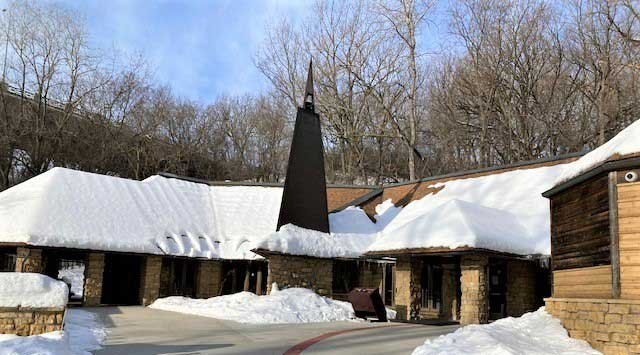Adventures at Fort Snelling State Park – A Guided Winter Stroll
By Deborah Locke, DNR Information Officer
In the world of animals, a skinny short branch sticking out of the snow with stripped bark is the equivalent of a dating app. The adult male buck that stripped the bark left behind his scent for any interested doe. The scent identified the deer, and also indicated his status among the herd, and more.
We learned the above on a “River Walk” program at Fort Snelling State Park on a Saturday morning in February. Interpretive naturalist Kao Thao led the small group about a half mile down a trail and toward a confluence of the Mississippi and Minnesota rivers lined by acres of trees.
The purpose that day was to pay attention to signs of life among the plants and animals that call the park home. Small branch shoots lining the trail could be buckthorn or the start of a Hackberry tree. Scattered everywhere were animal tracks, mostly rabbits, whose prints told Kao how fast they were moving and the direction they were headed. As we walked, Kao noticed a curious deer off on the right that watched us with great interest.
Many Minnesota state park naturalists offer programs and events designed to enlighten, entertain, and help the public develop skills. Naturalists like Kao are people with a passion for teaching, and for conserving and protecting public land. These are the folks who know the parks and trails best and keep a close eye on changing conditions like fallen trees or flooded areas. I’ve been with a naturalist who noticed a distant new woodpecker hole in a trunk. Another one was so good with identifying birdcalls that he could tell from the sound if the bird was calling out a warning or attempting to attract a mate. We heard a chickadee as we walked that morning, which Kao identified as male because of its high pitch.
From the trail and just before reaching the rivers, Kao pointed a downed tree with clear damage from beavers. The beaver lodge was about 150 feet away around a bend in the river; before us was a massive trunk. The beavers eat a substance beneath the bark from smaller branches and hoard a large supply of branches outside their dens which provides food during the winter months.
You may be wondering why anyone would want to walk down to a river in the winter. A winter walk consumes some energy, but it also generates energy. It provided pep to get through the rest of the day. The walk also opened my eyes and ears to the stark evidence of activity in what appears to be a still environment. How lucky were we to get in a short hike while simultaneously learning about the wilderness within a larger metropolitan environment. Care to see for yourself? See the Parks and Trails website for statewide offerings of naturalist programs.
Sometimes it is necessary to register online for a state park and trail naturalist program. On rare occasion, a fee is charged for materials. The only certain expense you can expect is the necessity of a vehicle day permit ($7) to enter the park. To find a program to attend at a Minnesota state park, go to https://www.dnr.state.mn.us/state_parks/events.html. If you’re wondering where to go, see a map of state parks at: https://www.dnr.state.mn.us/state_parks/map.html
Images courtesy Minnesota DNR Staff












